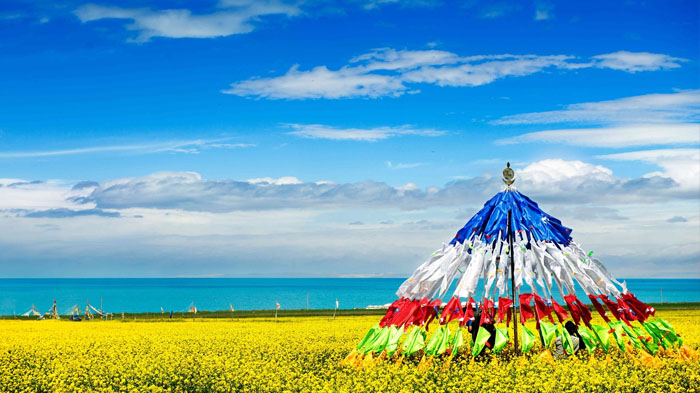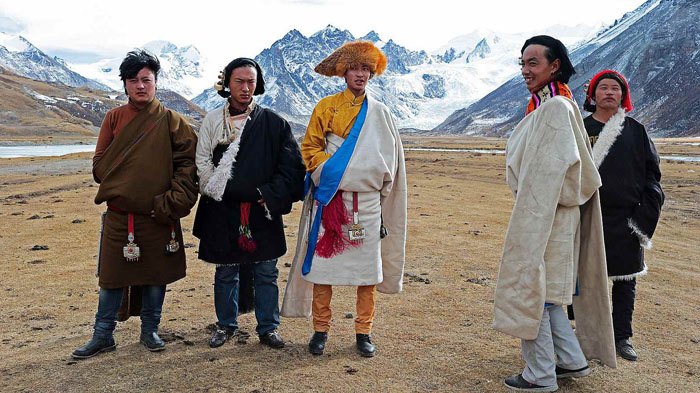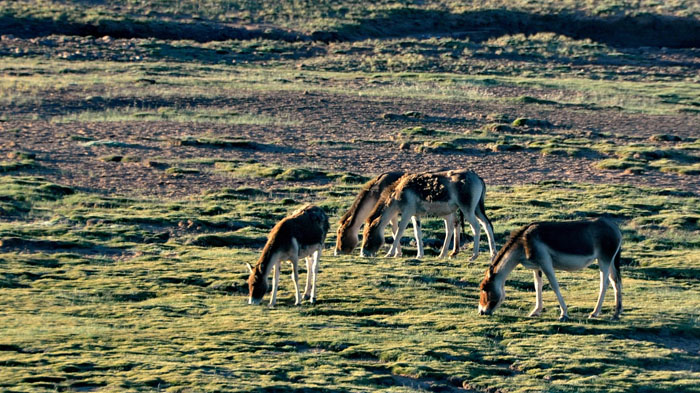
Amdo Kham Tour: Another Great Choice to Experience Distinct Tibetan Culture and Landscape
Traveling to Tibet is a journey that requires some pretty strict red tape, with visas, permits, and the need to have a pre-booked tour and tour guide with private vehicle. This makes it a more expensive option for many people, instead of having the ability to travel as cheaply as possible.
For those travelers that want to experience the unique Tibetan culture and religion, but cannot manage to get to the Tibet Autonomous Region (TAR), there is another option. Ancient Tibet was originally split into three regions, U-Tsang, Amdo and Kham. And while the Tibet Autonomous Region has strict rules on tourism, there are parts of Amdo and Kham which are outside the TAR, and are not subject to the same strict regulations.
Where are Amdo and Kham
Taking up most of the Chinese province of Qinghai, as well as small parts of south-western Gansu Province and northwest Sichuan Province, the ancient area of Amdo is almost completely outside the modern-day Tibet. Similarly, while most of the region resides inside the TAR, the ancient Kham region has areas outside Tibet, extending into major parts of western Sichuan Province, small areas of southern Qinghai Province, and a small part of northern Yunnan Province.
 Jiaju Tibetan Village in Kham
Jiaju Tibetan Village in Kham
Thanks to these ancient areas, which are still mostly populated by Tibetans, it is possible to travel around authentic Tibetan villages and towns, and experience the Tibetan religion and culture without having to travel all the way to Tibet to do so. There is no doubt that Amdo and Kham are the perfect places that you can enjoy a Tibet tour without permit.
Topography, Climate and Tibetans in Amdo and Kham
Consisting of the entire northeastern area of Tibet, Amdo is a wind-swept and treeless land, with plains and prairies that extend for hundreds of kilometers. An area that is home to the wild yaks and kiang of the northern grasslands, it is bordered to the south by the Bayan Har Mountains and contains the upper reaches of the Yellow River and Qinghai Lake.
The original inhabitants of Amdo were non-Tibetan, mostly Mongols and the Tibetan-speaking Hor tribes. While still considered to be ethnically Tibetan, the Tibetan people of Amdo are known more distinctly as Amdowa, or Amdo pa, which distinguishes them from the Tibetans of U-Tsang in central Tibet and the people of Kham, known as Khampa.
The Amdowa are the predominant culture across Qinghai Province, covering majority of the area, though the highest density of population is the Han ethnic culture in eastern Qinghai and Xining, the provincial capital. Despite this, many of the areas of Qinghai are administered as Tibetan Autonomous Prefectures, covering the whole of southern and western Qinghai Province.
 Qinghai Lake is a famous attraction in Amdo Tibet
Qinghai Lake is a famous attraction in Amdo Tibet
Qinghai is known in China as the perfect summer holiday getaway, due to its milder climate. Winters, while still quite cold, are often a lot milder than those of central and northern China, where heavy snow is common. Summers are a lot milder as well, being cooler than central and southern China in the peak months of the summer, making it an ideal place to travel for a cooler summer break.
To the south of Amdo, the ancient region of Kham consists of areas of rugged terrain, high mountains, and deep valleys, with mountain ridges and gorges running across the region from the northwest to southeast. Collectively known as the Hengduan Mountains, this area is still one of the most beautiful of all the ancient Tibetan regions, with the Mekong, Yangtze, and Salween rivers flowing through it.
Nowadays, the area of Kham has been split between Sichuan, Yunnan, Qinghai, and Tibet Autonomous Region, with 25 of the 50 counties inside the TAR. Majority of the area of Kham outside Tibet lies in Sichuan Province, consisting of 16 counties to the west of Chengdu, the provincial capital. Three counties also exist in Yunnan and another six in Qinghai.
Kham is known these days as the Ethnic Corridor of Southwest China, due to its large number of ethnic cultures. This vast yet sparsely populated area is inhabited by 14 different ethnic groups of Khampa, and there are 12 distinct languages spoken by around one third of the people that are different to the standard Khams Tibetan spoken in most of the area.
 The Local Tibetans living in Kham area in Sichuan province
The Local Tibetans living in Kham area in Sichuan province
The climate in Kham is one of mild yet harsh weather, with warm pleasant springs, summer and autumn, heavier monsoons that in the rest of Tibet, and milder winters, except on the mountains. Climates change in Kham depending on how high you are, with sub-tropical regions in the lower valleys extending up to alpine climate conditions on the high snow mountains.
Top 5 Attractions in Amdo and Kham Respectively
Amdo
Qinghai Lake in Amdo, also known as Koko Nor or Tso Ngongpo, is the largest saltwater lake in China. Lying in an area of outstanding natural beauty, this huge lake lies between Hainan and Haibei Tibetan Autonomous Prefectures and sits at the conjunction of more than a dozen bird migrations routes that stretch across Asia, from Siberia to Indonesia. The lake includes several islands, some of which have been designated as bird sanctuaries and one with its own temple and hermitages. The lake is frozen over for three months of the year in the winter, and the island hermitages were regularly used as retreats for Buddhist monks, who would spend nine months of the year in isolation.
While it is actually in Huangzhong County of Xining, the Kumbum Monastery, or Ta’er Monastery, is one of the most important monasteries in Amdo. A subsidiary monastery to Drepung Monastery in Lhasa, it was built in the 16th century by the third Dalai Lama and lies in a narrow valley near the small village of Lusar. It is said that the sandalwood tree that grows in the monastery sprung up on the site where blood of the founder of the Gelug School of Tibetan Buddhism, Je Tsongkhapa, fell after his birth.
Hoh Xil, or Kekexili, is an area in Amdo that is known for its stunning wildlife and vast expansive prairies. Known as the Blue Ridge in Mongolian and the “Lord of Ten thousand Mountains”, this isolated region in the northern part of the plateau lies between the Kunlun Mountains and the Tanggula Mountains, close to the boundary with the Tibet Autonomous Region. Despite its harsh northern plateau climate, this vast area is home to hundreds of species of wild animals and birds, including the wild yak, the kiang or Tibetan wild donkey, white lipped deer, brown bears, and the rare and endangered chiru or Tibetan antelope.
 Kekexili (Hoh Xil): the vast land in Amdo is also a paradise for wild animals.
Kekexili (Hoh Xil): the vast land in Amdo is also a paradise for wild animals.
The Princess Wencheng Temple is a small but busy temple that lies around 15km to the south of Yushu town that has been dedicated to one of Tibetan history’s greatest women, Princess Wencheng of the Tang Dynasty. One of the many wives of the 7th century Tibetan king, Songtsen Gampo, it is said that the temple was built on the spot where the Princess’s caravan stopped en-route to her wedding with the Tibetan king. The temple also has a rock carving of the Nampa Namse, the Buddha of primordial wisdom, which dates from around the 8th century and is said to have arisen without being carved.
The Baigong Pipes, also known as the Delingha Pipes, are a series of pipe-like structures, which some believe to be the fossilized remnants of trees. Found on and around the White Mountain or Mount Baigong, to the southwest of the city of Delingha, these strange pipes have been discovered in several caves inside the mountain, as well as sticking out from the mountain’s slopes. The same pipe-like features have also been found lying flat on the shores of the Tuoso Lake, some 80 meters from the mouth of the caves, as well as standing pipes under the surface of the water. One of the great mysteries of ancient Tibet, the pipes have been analyzed to be made of ferric oxide, silicon dioxide, and calcium oxide, and some have even been found to be radioactive.
Kham
Mount Gongga, also known as Minya Konka, is the highest mountain in Sichuan Province, and is within the region once known as Kham. Known locally as the “King of Sichuan Mountains”, this holy mountain lies in the Daxue Shan Mountain Range, part of the Hengduan Mountains. The easternmost peak over 7,000 meters, the mountain is one of the famous holy Snow Mountains of Tibet, which is covered in snow all year round. On its slopes lies the Minya Konka Monastery, or Gongga temple, a monastery of the Kagyu School of Tibetan Buddhism and one of the places visited by the explorer, Joseph Rock, one of the first western explorers to visit this part of China in the 1920s.
Named after the legendary location from the novel Lost Horizon by James Hilton of a mysterious and harmonious paradise in the Himalayas, Shangri La is a small town in Dechen Tibetan Autonomous Prefecture of Yunnan Province that is famous for its natural landscapes. A popular tourist destination in southwest China, the area is covered in natural forests and surrounded by snow-capped mountains.
Mount Yala, one of the holy Snow Mountains of Kham, lies on the conjunction of four counties in Sichuan Province, partly in the Garzê Tibetan Autonomous Prefecture. One of the most popular places in Sichuan Province for mountain trekking, the peak is covered with snow all year round and is part of the Mount Yala Nature Preserve. Mentioned in the Tibetan legend, the “Epic of King Gesar”, the mountain is visited by many Tibetans every year to hang their prayer flags on its snowy peak.
 Yala Snow Mountain and Tagong Temple in Kham Tibet
Yala Snow Mountain and Tagong Temple in Kham Tibet
With more than 12 centuries of history, the Dzongsar Monastery in Garze is an iconic monastery in the Kham region of ancient Tibet. Founded in 746 AD, the temple started life as a shrine built by a Bonpo Lama, and has been a monastery for both the Nyingma and Kadampa Schools of Tibetan Buddhism within the first 500 years. After being partially destroyed, it was later rebuilt as a Sakya monastery, which it remains to this day.
Lying in the rural setting of Daocheng County in Garze, Yading Village is one of the most popular tourists destinations in the area, and is often used as a base for trekking around the nearby mountains and the Yading Nature Reserve. The reserve is also the location of three of the holiest mountains outside Tibet, Chenrezig, Jampayang, and Chenadorje, which form a triangle around densely forested valleys, pristine lakes, and clear rivers. One of the best treks in Sichuan Province, the three mountains represent three Bodhisattvas in Tibetan Buddhism, Mercy, Wisdom, and power.
Recommended Travel Route for Amdo and Kham Tour
If you are planning to tour around the areas of Amdo and Kham together, then you will need to have at least two weeks spare to travel around these ancient Tibetan regions. The ideal tour will start in Xining, in Qinghai Province, and travel through the area of Amdo first, exploring such stunning sites as the White Monkey Fortress, Mount Amnye Machen, and Yushu (including the Horse Racing Festival if you are there at the right time of year).
>> 5 Days Amdo Tibet Nomadic Life Experience Tour from Xining
After leaving Amdo and traveling to Kham in Sichuan Province, which can be done by train, you will get to travel around the Sichuan part of Kham, outside the TAR. Starting outside Chengdu, you can travel west along the G318 National Road, also known as the Sichuan Tibet Highway, to Kangding, a small town that is the center of the Mount Gongga region. From there you can experience the stunning sight of Minya Konka, with its ancient monastery, and the delights of the Tagong grasslands, one of the most expansive areas of prairie in Kham.
>> 6 Days Amazing Kham Tour from Chengdu by overland
How to Prepare for Amdo and Kham Tour
As mentioned, for a good tour of Amdo and Kham, you need at least two weeks to travel around the regions, though more would be better. However, this is enough time to see many of the stunning sights of these ancient Tibetan areas without feeling like you are rushing, as rushing is not possible when traveling around such stunning landscapes.
This kind of Amdo Tibet tour and Kham Tibet tour can be done on your own, as it is not inside the Tibet Autonomous Region, and the restrictions there do not apply. However, you cannot drive in China as an international tourist, and the buses, while very good, may not cover all the places that you wish to visit. The best option for travel, if you want to get to the places you wish to see without much hassle, is to book a tour that covers both regions, with a driver and guide.
The only documents that you need for traveling in the areas of Kham and Amdo outside the TAR is the Chinese Entry Visa, as there are fewer restrictions in these areas of China than in Tibet itself. Your hotels should be pre-booked, as should your itinerary, but it is relatively easy to change those once you have started your tour, if you wish to make changes. Tours in Amdo and most of Kham are similar to traveling around the rest of China.
Even if you are traveling in the summer months, it is a good idea to make sure that you have some warm clothing with you. Days can be warm enough, but you are still on the vast Tibetan plateau, at altitudes often above 3,000 meters, and it can still get cold at night. Good strong hiking boots are a must, as much of the regions are rough and rugged terrain, even where there are monasteries and small villages.

Energetic, responsible and reliable, Sonam is a guide with more than seven years experience informing visitors about heritage sites and attractions places in Tibet.


.jpg)


0 Comment ON "Amdo Kham Tour: Another Great Choice to Experience Distinct Tibetan Culture and Landscape"